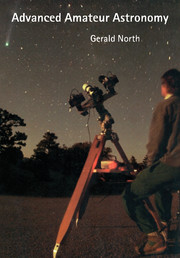Book contents
- Frontmatter
- Contents
- Preface to the second edition
- Preface to the first edition
- Acknowledgements
- 1 Telescope optics
- 2 Atmosphere, seeing, magnification and eyepieces
- 3 Telescope hardware and adjustments
- 4 Astrophotography with the camera
- 5 Astrophotography through the telescope
- 6 Electronic imaging
- 7 The Moon
- 8 The terrestrial planets
- 9 The gas-giant planets
- 10 Asteroids, comets, meteors and aurorae
- 11 The Sun
- 12 Variable stars and novae
- 13 Methods of photometry
- 14 Double stars, star clusters, nebulae, galaxies and supernovae
- 15 Spectroscopy
- 16 Radio astronomy
- 17 Further information
- Appendix: Useful formulae
- Index
10 - Asteroids, comets, meteors and aurorae
Published online by Cambridge University Press: 04 August 2010
- Frontmatter
- Contents
- Preface to the second edition
- Preface to the first edition
- Acknowledgements
- 1 Telescope optics
- 2 Atmosphere, seeing, magnification and eyepieces
- 3 Telescope hardware and adjustments
- 4 Astrophotography with the camera
- 5 Astrophotography through the telescope
- 6 Electronic imaging
- 7 The Moon
- 8 The terrestrial planets
- 9 The gas-giant planets
- 10 Asteroids, comets, meteors and aurorae
- 11 The Sun
- 12 Variable stars and novae
- 13 Methods of photometry
- 14 Double stars, star clusters, nebulae, galaxies and supernovae
- 15 Spectroscopy
- 16 Radio astronomy
- 17 Further information
- Appendix: Useful formulae
- Index
Summary
For many people the Bohemian asteroids, ghostly comets, flaring meteors and ethereal aurorae are what astronomy is all about. These objects and phenomena rarely fail to strike up feelings of wonder in astronomers and lay persons alike. These are also areas where amateur endeavours are preeminent. The last time an amateur discovered a major planet was way back in 1781. I am probably not sticking my neck out too far in stating that the chances of a modern-day amateur doing the same are nil. However, there is every chance that you might discover a new comet or asteroid, or observe a particularly spectacular fireball-meteor, or a vivid aurora. Even if you do not make the actual discovery, you can still provide observations of real scientific value.
Observing asteroids
Known asteroids can be located from their ephemerides. Thousands have been discovered so far and many more remain yet to be found. They can be hunted down visually, though there is little to distinguish their appearances from stars, apart from their relative motions. Undoubtably the best way to discover new asteroids is to use wide-field photography. A Schmidt camera is the ideal tool to use but, failing that, use any camera capable of giving a fairly wide field of view (several degrees) and with the largest possible aperture. Figure 10.1 shows a photograph of the asteroid 5 Astraea as it passed through the Beehive star cluster.
- Type
- Chapter
- Information
- Advanced Amateur Astronomy , pp. 221 - 248Publisher: Cambridge University PressPrint publication year: 1997



